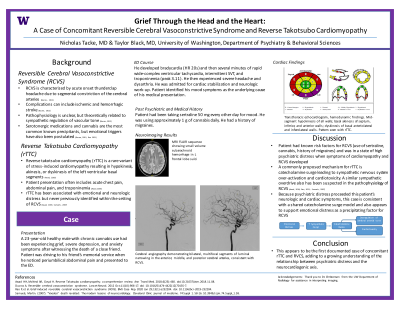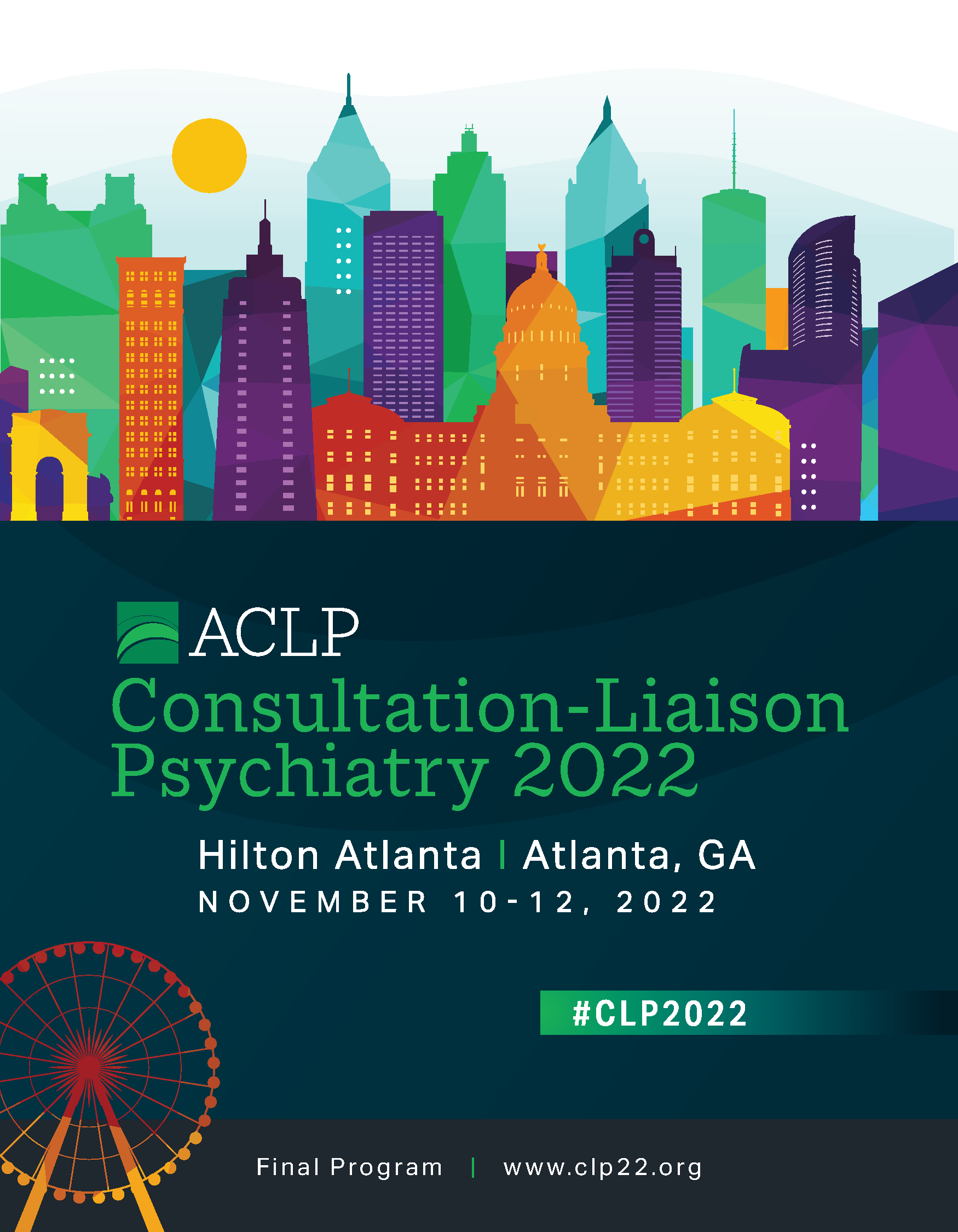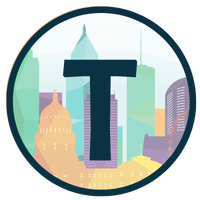Back

Cardiology
Poster Session
(006) Grief through the head and the heart: A case of concomitant reversible cerebral vasoconstrictive syndrome and reverse takotsubo cardiomyopathy

Abstract:
Background:
Reversible cerebral vasoconstrictive syndrome (RCVS) is characterized by acute thunderclap headache due to sudden, segmental constriction of the cerebral arteries that can lead to hemorrhagic stroke. Two common precipitants are serotonergic medications and cannabis due to their vasoconstrictive properties, but emotional triggers also have been postulated (Ducros, 2012; Rao 2021). Neurologic emergencies (including RCVS and subarachnoid hemorrhage) have been associated with developing stress-induced cardiomyopathy (Samuels, 2007). Reverse takotsubo cardiomyopathy (rTTC) is a rare variant of stress-induced cardiomyopathy almost exclusively associated with emotional or physical distress and never previously identified within the setting of RCVS (Awad, 2018).
Case:
A 23-year-old healthy male with chronic cannabis use had been experiencing severe depression and anxiety symptoms after witnessing the death of a close friend. Patient was driving to his friend’s memorial service when he noticed periumbilical abdominal pain and presented to the ED. He developed bradycardia and then several minutes of rapid wide-complex ventricular tachycardia, intermittent SVT, and troponinemia (peak 3.11). He then experienced severe headache and dysarthria. He was admitted for cardiac stabilization and neurologic work-up. Neuroimaging and cerebral angiography showed left frontotemporal and right frontal sulci subarachnoid hemorrhage as well as segmental vasculitic changes of the bilateral anterior, middle, and posterior cerebral arteries, consistent with RCVS. Echocardiogram demonstrated mild to moderately decreased global left ventricular function (EF 39%) with mid-segment hypokinesis and apical hyperdynamic contraction, a pattern seen with rTTC. Psychiatry was consulted for assistance with management of depression/anxiety, and patient identified his mood symptoms as the underlying cause of his medical presentation.
Discussion:
Patient had known risk factors for RCVS (use of sertraline, cannabis) and was in a state of high psychiatric distress when symptoms of cardiomyopathy and RCVS developed. A commonly proposed mechanism for rTTC is catecholamine surge leading to sympathetic nervous system over-activation and cardiotoxicity (Awad, 2018; Samuels, 2007). A similar sympathetic overdrive also has been suspected in the pathophysiology of RCVS (Rao, 2021). Because psychiatric distress proceeded this patient’s neurologic and cardiac symptoms, this case is consistent with a shared catecholamine surge model and also appears to support emotional distress as a precipitating factor for RCVS.
Conclusion/Implications:
This appears to be the first documented case of concomitant rTTC and RVCS, adding to a growing understanding of the relationship between psychiatric distress and the neurocardiogenic axis.
References:
Awad HH, McNeal AR, Goyal H. Reverse Takotsubo cardiomyopathy: a comprehensive review. Ann Transl Med. 2018;6(23):460. doi:10.21037/atm.2018.11.08.
Ducros A. Reversible cerebral vasoconstriction syndrome. Lancet Neurol. 2012 Oct;11(10):906-17. doi: 10.1016/S1474-4422(12)70135-7.
Rao P, et al. Grief-induced reversible cerebral vasoconstriction syndrome (RCVS). BMJ Case Rep. 2020 Jan 29;13(1):e232204. doi: 10.1136/bcr-2019-232204.
Samuels, Martin. (2007). "Voodoo" death revisited: The modern lessons of neurocardiology. Cleveland Clinic journal of medicine. 74 Suppl 1. S8-16. 10.3949/ccjm.74.Suppl_1.S8.
Background:
Reversible cerebral vasoconstrictive syndrome (RCVS) is characterized by acute thunderclap headache due to sudden, segmental constriction of the cerebral arteries that can lead to hemorrhagic stroke. Two common precipitants are serotonergic medications and cannabis due to their vasoconstrictive properties, but emotional triggers also have been postulated (Ducros, 2012; Rao 2021). Neurologic emergencies (including RCVS and subarachnoid hemorrhage) have been associated with developing stress-induced cardiomyopathy (Samuels, 2007). Reverse takotsubo cardiomyopathy (rTTC) is a rare variant of stress-induced cardiomyopathy almost exclusively associated with emotional or physical distress and never previously identified within the setting of RCVS (Awad, 2018).
Case:
A 23-year-old healthy male with chronic cannabis use had been experiencing severe depression and anxiety symptoms after witnessing the death of a close friend. Patient was driving to his friend’s memorial service when he noticed periumbilical abdominal pain and presented to the ED. He developed bradycardia and then several minutes of rapid wide-complex ventricular tachycardia, intermittent SVT, and troponinemia (peak 3.11). He then experienced severe headache and dysarthria. He was admitted for cardiac stabilization and neurologic work-up. Neuroimaging and cerebral angiography showed left frontotemporal and right frontal sulci subarachnoid hemorrhage as well as segmental vasculitic changes of the bilateral anterior, middle, and posterior cerebral arteries, consistent with RCVS. Echocardiogram demonstrated mild to moderately decreased global left ventricular function (EF 39%) with mid-segment hypokinesis and apical hyperdynamic contraction, a pattern seen with rTTC. Psychiatry was consulted for assistance with management of depression/anxiety, and patient identified his mood symptoms as the underlying cause of his medical presentation.
Discussion:
Patient had known risk factors for RCVS (use of sertraline, cannabis) and was in a state of high psychiatric distress when symptoms of cardiomyopathy and RCVS developed. A commonly proposed mechanism for rTTC is catecholamine surge leading to sympathetic nervous system over-activation and cardiotoxicity (Awad, 2018; Samuels, 2007). A similar sympathetic overdrive also has been suspected in the pathophysiology of RCVS (Rao, 2021). Because psychiatric distress proceeded this patient’s neurologic and cardiac symptoms, this case is consistent with a shared catecholamine surge model and also appears to support emotional distress as a precipitating factor for RCVS.
Conclusion/Implications:
This appears to be the first documented case of concomitant rTTC and RVCS, adding to a growing understanding of the relationship between psychiatric distress and the neurocardiogenic axis.
References:
Awad HH, McNeal AR, Goyal H. Reverse Takotsubo cardiomyopathy: a comprehensive review. Ann Transl Med. 2018;6(23):460. doi:10.21037/atm.2018.11.08.
Ducros A. Reversible cerebral vasoconstriction syndrome. Lancet Neurol. 2012 Oct;11(10):906-17. doi: 10.1016/S1474-4422(12)70135-7.
Rao P, et al. Grief-induced reversible cerebral vasoconstriction syndrome (RCVS). BMJ Case Rep. 2020 Jan 29;13(1):e232204. doi: 10.1136/bcr-2019-232204.
Samuels, Martin. (2007). "Voodoo" death revisited: The modern lessons of neurocardiology. Cleveland Clinic journal of medicine. 74 Suppl 1. S8-16. 10.3949/ccjm.74.Suppl_1.S8.

Nicholas F. Tacke, MD
Psychiatry Resident
University of Washington
Boise, ID, United States- TB
TAYLOR BLACK, MD
Assistant Professor
University of Washington
SEATTLE, Washington, United States


